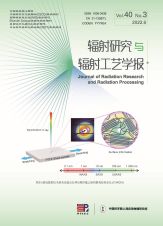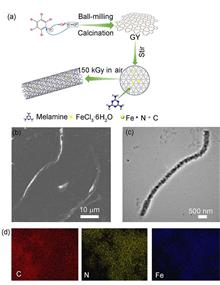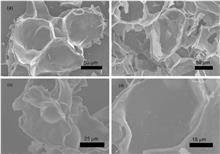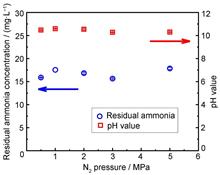 View fulltext
View fulltext
In this study, graphdiyne was prepared using a γ-irradiated N-doping photogram to transform two-dimensional graphdiyne into a one-dimensional tubular structure for use as substrate-supported iron nanoparticles for cathodic redox reaction (ORR) in fuel cells. Methods such as scanning electron microscopy, X-ray diffraction, Raman spectroscopy, and isothermal nitrogen adsorption and other characterization methods were used to characterize and analyze the surface morphology, element composition, crystalline structure, and defect degree of the prepared composites. In the alkaline solution, the prepared catalyst was characterized by ORR performance, four-electron selectivity, kinetics and stability via cyclic voltammetry test, linear sweep voltammetry test and electrochemical AC impedance spectroscopy test. The results showed that after γ-ray irradiation, the nitrogen-doped graphite monoalkyne-loaded iron nanoparticle (NGY-Fe) catalyst had a larger specific surface area (411.3 m2/g) and a multilevel pore structure, which was conducive to the exposure of the active center. Moreover, the O2 permeation barrier was decreased, and the ORR activity of the NGY-Fe was significantly improved, especially in terms of the stability and methanol resistance, which were far superior to those of the commercially available commercial Pt/C catalysts.
In this study, self-doping defects were introduced to optimize the interlayer spacing and pore structure of hard carbon by γ-ray irradiation. The effects of the absorbed dose on the interlayer spacing, internal defects, and disordered structure of hard carbon were investigated through scanning electron microscopy (SEM), X-ray diffraction (XRD), Raman spectroscopy, and isothermal nitrogen adsorption/desorption. The electrochemical properties were investigated using the constant current charge-discharge. The results showed that the surface crystallinity and disordered structure of hard carbon increased with the absorbed dose. Moreover, the electrochemical properties of hard carbon were clearly improved. At a dose of 140 kGy, hard carbon presented a high specific surface area of 425.343 m2/g and provided a sodium storage capacity of 300 mAh/g at 30 mA/g; the high current density capacity remained at 195 mAh/g at 1 A/g, suggesting that the electrode capacity increased three-fold. Excellent stability was also maintained during high-rate charge-discharge. This work provides new approaches and ideas for the design of advanced nanomaterials and defect engineering applications in the field of energy storage.
In this study, four typical metal-organic frameworks (MOFs), (MIL-101 (Cr), ZIF-8, UiO-66, and UiO-66-NH2) were irradiated using electron beam radiation under different atmospheres (air, nitrogen), and dispersion liquids (water, methanol, and ethanol). The chemical composition, crystal structure, and surface morphology of MOFs before and after irradiation were characterized by Fourier transform infrared spectroscopy, X-ray diffraction spectroscopy, and scanning electron microscopy. The results showed that the corresponding infrared characteristic peaks, diffraction peaks, and surface morphology characteristics of all four MOFs did not change significantly after irradiation at the dose of 5 000 kGy, showing good radiation stability. This provides the basis for further application of MOFs in a radiation environment.
In some reactors, ammonia and its radiolytic product (H2) are used to scavenge the oxidizing species (H2O2, O2, and ?OH). A reducing chemical environment is thus created and the pH of the coolant is regulated simultaneously. In the present study, the radiolytic behaviors of deoxygenated ammonia solution were studied in the γ-ray field. The impacts of N2 pressure, gas-liquid volume ratio, and temperature on deoxygenated ammonia solution radiolysis were investigated. The pH and the concentrations of residual ammonia, H2, and nitrogen oxides (NO2- and NO3-) were analyzed. The results revealed that the variation of N2 pressure (0.5~5.0 MPa) and gas-liquid volume ratio had no influence on the concentrations of residual ammonia and nitrogen oxides. NO2- and NO3- concentrations were approximately 1 mg/L at room temperature when the absorbed dose was 28.8 kGy. However, the apparent concentration of H2 significantly decreased with the N2 pressure and gas-liquid volume ratio. The loss fraction of ammonia considerably declined from 26.5% to 8.4% when the temperature increased from 25 to 200 ℃, demonstrating that the radiolysis of ammonia was suppressed at the elevated temperature. However, the concentrations of NO2- and NO3- increased to 34 and 3 times, respectively, at 200 ℃ compared to those at 25 ℃. In addition, a radiolysis model of ammonia-containing coolant was established in the present study. The maximum relative error between experimental data and calculation results at any temperature was 4.1%. The model was thereafter used to calculate residual ammonia concentration with the absorbed dose under different initial ammonia concentrations. The results revealed that it was necessary to replenish ammonia regularly when using it alone to inhibit oxidizing species.
Investigations on the damage and degradation mechanisms of epoxy resin under a high-energy irradiation and improvement in its stability in irradiation environments are crucial to expand the application of epoxy resin in numerous fields including the aerospace and nuclear industries. In this study, graphene quantum dots (GQDs) were used as free radical scavengers to slow down the degradation of epoxy resin under a γ-irradiation environment, and the anti-irradiation mechanism of the GQDs on epoxy resin was investigated. The results demonstrated that following irradiation, the mechanical properties of epoxy resin exhibited a reduction of 49%, accompanied by a decrease in glass transition temperature by 4.4 ℃. Similarly, the mechanical properties of graphene quantum dots/epoxy resin (GQDs/EP) composites experienced a decline of 35%, along with a decrease in glass transition temperature by 2.2 ℃. Notably, upon the incorporation of GQDs, the generation of free radicals within irradiated GQDs/EP composites was significantly suppressed compared to pure resin. Furthermore, GQDs nanoparticles enhanced both the mechanical properties and thermal stability of epoxy resin prior to and after irradiation. Therefore, GQDs nanoparticles can be used as free radical scavenger to effectively improve the irradiation stability of epoxy resin. The scavenging mechanisms for free radicals mediated by GQDs is closely associated with sp2 carbon domains and surface functional groups. This study provides a novel concept and method to improve the stability of epoxy resin under γ-ray radiation.
Ta-doped lithium-lanthanum-zirconium-oxygen (Li6.5La3Zr1.5Ta0.5O12, LLZTO) solid electrolytes with a high ionic conductivity at room temperature were prepared by the solid-phase reaction method, and the effects of irradiated electron beams on their structure and properties were investigated in detail. The results showed that no other heterogeneous phases were produced after irradiation with different doses (250 kGy and 500 kGy) of electron beams, and the lattice spacing became larger with an increase in the dose, which is conducive to the reduction of the diffusion energy barrier of ions in the lattice. First-principles calculations revealed that the Li+ diffusion energy barrier of the low-dose electron-beam irradiated sample was reduced by 0.07 eV compared with that of the unirradiated sample, suggesting that the defects created by irradiation can promote Li+ diffusion. An AC impedance test of the electrolytes before and after irradiation further confirmed that low-dose electron beam irradiation is beneficial for enhancing their ionic conductivity. Exploring the effect of electron beam irradiation on the structure and conductivity of LLZTO oxide solid state electrolytes holds significance in the study of solid state electrolytes.
To further understand the role of low-energy N+ implantation in the phylogenetic evolution and characterization of drug resistance in Escherichia coli (E.coli), this study used low-energy N+ ion implantation to screen for drug resistant E.coli. The 16S rRNA gene sequences were obtained through de novo genome sequencing, and the drug resistance characteristics of mutant strains were assessed using the K-B method. Twenty-five drug-resistant strains were obtained by mutagenesis. The 16S rRNA in five mutant strains had a point mutation (A257C) or a gene deletion in C1, V1, V2, V6-V9, and C6-C9 regions, respectively. GC content increased and the mutation rate reached 0.4%-0.6%. The results indicate that low-energy N+ ion implantation could trigger mutations and drive 16S rRNA gene evolution in E.coli., which could accelerate development of antibiotic resistance in E.coli.
Mulch film has provided significant convenience for agricultural development. However, its stable physical and chemical properties make it challenging to manage under natural conditions, potentially posing a serious environmental threat if mishandled. This study investigates the influence of various experimental factors on the degradation of agricultural film using low-temperature plasma degradation technology. A self-made needle-plate electrode structure was employed to treat polyethylene film with a high-frequency AC voltage. The study analyzesd the effects of input power, discharge time, electrode number, and air circulation on mulch film degradation. Changes in mulch quality, Raman spectrum, scanning electron microscope observations, and relative molecular mass were compared before and after treatment. The results revealed a 2.6-fold increase in mulch film degradation efficiency when the input power rised from 26 W to 80 W. While increasing input power enhanced high-energy electrons and active substances in the reaction space, energy efficiency did not proportionally increase with the degradation rate. At 51 W input power, the energy efficiency reached a maximum of 58.82 μg/(W·h). The number of needle tips influences plasma uniformity and input power, impacting film degradation efficiency. As the number of needle electrodes increases, film degradation efficiency initially decreased from 3.49% to 2.1%, then rised to 3.57%. Prolonged discharge time made the molecular chain structure more vulnerable to plasma attack and breakage. Additionally, air fluidity affects ozone concentration in the reactor, with higher concentrations in a closed environment at low input power. Increasing the input power to 80 W results in higher ozone concentration with good air fluidity, aiding in improving mulch film degradation efficiency.
Brassica oleracea is one of the important vegetable crops in China. Its seeds are primarily imported. Hence, developing innovative varieties belonging to China is an urgent requirement. Since broccoli is a cross-pollinated crop systematic selection and cross-breeding are challenging, and the application of radiation mutagenesis breeding in broccoli has not been reported. In this study, the seeds of Brassica oleracea were irradiated using carbon ion beams to investigate the biological effects of these beams on broccoli. The growth indices, antioxidant enzyme activity, photosynthetic indices, and chlorophyll fluorescence were detected at the seedling stage. The results revealed that irradiation with 100–500 Gy exhibited no significant effect on the germination of Brassica oleracea, while the germination of seeds was significantly inhibited at 600 Gy. After irradiation with 100–600 Gy, the root length, shoot length, seedling height, and leaf area decreased with the increase in irradiation dose. The Median lethal dose (LD50) of Brassica oleracea irradiated using a carbon ion beam was 415.89 Gy, and the dose that halved the root length was 495.12 Gy. After irradiation, the activities of superoxide dismutase (SOD) and peroxidase (POD) were higher than that of the control plants, while the activity of catalase (CAT) was lower than that of the control plants. The content of malondialdehyde (MDA) increased significantly at a dose of 400 Gy. The photosynthetic pigments (chlorophyll a, chlorophyll b, and carotenoids) showed an increasing trend initially, and then a decreasing trend with an increasing irradiation dose, and the highest value was detected at a dose of 300 Gy. Net photosynthesis, transpiration rate, and stomatal conductance exhibited a negative correlation with irradiation dose, while the non-photosynthetic quenching coefficient exhibited a significant increase after irradiation. The findings indicated that heavy ion beam radiation inhibited the growth of broccoli plants and affected the activity of antioxidant enzymes and photosynthesis. The study provided basic data for the radiation mutation breeding of Brassica oleracea.
Path planning for the complete coverage of nuclear radiation fields is necessary to ensure the radiation safety of regional operators in radiation environments. Based on a bio-inspired neural network algorithm, a complete coverage path-planning algorithm for the optimal control of the radiation dose is proposed. First, part of the terrain of the Fukushima nuclear power plant and the Monte Carlo particle transport program were used to construct the obstacle distribution and radiation dose field in a simulated nuclear radiation field. Subsequently, the Python programming language was used to conduct algorithm simulation experiments. Each grid of the simulated nuclear radiation field was defined as a neuron, and a bio-inspired neural network was established. The grid dose rate and neuronal activity were combined to achieve optimal control of radiation dose in path planning, and single, four, and eight mobile units were used for simulation experiments. The results showed that the planning path of a single mobile unit can achieve 100% coverage and a 4% coverage repetition rate and can first cover the low-dose area and delay the coverage of the high-dose area to achieve optimal control of the process and cumulative doses. The algorithm is improved via a multiunit collaborative search to increase the time efficiency of complete coverage and decrease the cumulative dose of monomers. The coverage repetition rates of four-unit and eight-unit simulations were 5.72% and 6.29%, respectively. The complete coverage times of the one-unit, four-unit, and eight-unit simulations were 30, 9, and 4 min, respectively, and the time efficiency was doubled. The maximum cumulative doses of the monomers for the one-unit, four-unit, and eight-unit simulations were 4.11×10-3, 1.28×10-3, and 0.85×10-3 mSv, respectively, which also decreased significantly. The proposed algorithm can achieve complete coverage path planning of optimal control of the process dose and cumulative dose. Moreover, the algorithm can coordinate multiunit path planning and significantly decrease the cumulative dose of monomers, which is critical for radiation protection during regional operations in a radiation environment.
Radiation monitoring is crucial to ensure safe, stable, and reliable operation of nuclear technology utilization equipment. The radiation levels at workplaces, in water storage wells, and due to individuals' occupational exposure during the operation of 60Co irradiation equipment over the past five years at the Hunan irradiation center have been monitored and analyzed. The results reveal that the radiation levels received by personnel and at various sites are remarkably lower than the national limits. All the source water quality indexes meet the requirements, and the radioactivity does not exceed the standard limits. The grey GM(1,1) prediction model was introduced to perform the prediction analysis based on 5 years of historical radiation monitoring data. The results show negligible change in the radiation level over the next 3 years, and it is considerably below the prescribed limit; hence, no radiation harm to the surrounding environment and human health would be observed.












